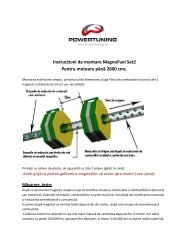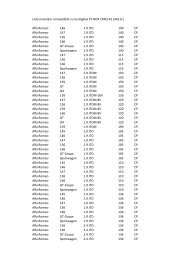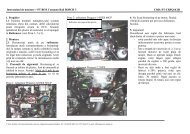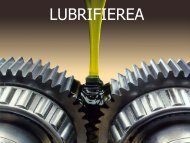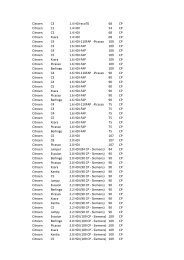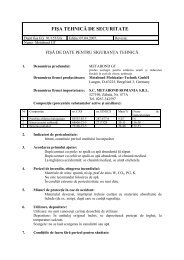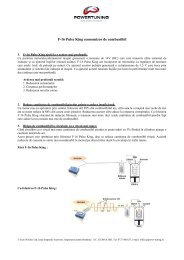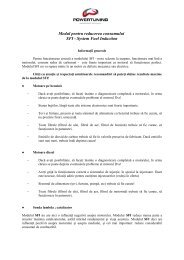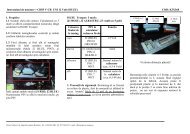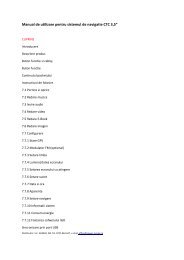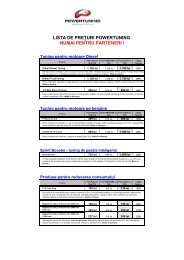Epreuve d'efficacité du système Econokit sur véhicule léger
Epreuve d'efficacité du système Econokit sur véhicule léger
Epreuve d'efficacité du système Econokit sur véhicule léger
- No tags were found...
Create successful ePaper yourself
Turn your PDF publications into a flip-book with our unique Google optimized e-Paper software.
ContentsParties involved .................................................................................................. 2Preamble ............................................................................................................ 2I. Summary of the results and conclusion of these tests. .................................. 31. Re<strong>du</strong>ction of fuel consumption ....................................................................... 42. Re<strong>du</strong>ction of polluting gas emissions .............................................................. 53. Conclusion of these tests ................................................................................ 6II. The variables used for these tests. ................................................................ 61. Con<strong>du</strong>ct of the test protocol ........................................................................... 72. Vehicle put in situation <strong>du</strong>ring the tests ......................................................... 83. Driving conditions ............................................................................................ 84. Instrumentation used .................................................................................... 10III. Appendix ................................................................................................... 111
Parties involvedController Applicant Place of testBUREAU VERITAS685 rue Georges ClaudeCS 6040113591 AIX EN PROVENCEECONOKIT361 avenue des romarins-Ecoparc-34130 SAINT AUNESMF POWERCOMPETITIONrue Jean de Guimarand13858 AIX LES MILLESPreambleThis document aims to present, in summary, the consistent benefits and developedmea<strong>sur</strong>ed by the system <strong>Econokit</strong>, in terms of re<strong>du</strong>ction of fuel consumption andre<strong>du</strong>ction of polluting gas emissions.Informative sources used are derived from:Mea<strong>sur</strong>ement and controls carried out by Bureau VERITAS of Aix enProvence 1 (independent certification organism).Information sent over the sensors installed by the manufacturer, andcollected through the OBD 2 plug of the vehicle.Mea<strong>sur</strong>ement software integrated with the dynamometer on which thevehicle was placed.All mea<strong>sur</strong>ements were systematically carried out by the engineer of the BureauVERITAS, in order to certify their accuracy.The vehicle chosen for these tests is representative of the European fleet becauseof its capacity, power, and its year of manufacture 3 , to provide a baselineeloquently for the reader.The first part of this report summarizes the results of these tests in terms ofre<strong>du</strong>ction of fuel consumption and polluting gas emissions, while the second part ofthis report details the proce<strong>du</strong>re of these tests, the vehicle characteristics used inthese tests, and instrumentation that allowed the statement of the mea<strong>sur</strong>esdescribed and discussed throughout the report.1 BUREAU VERITAS : 685 rue Georges Claude, CS 60401, 13591 AIX EN PROVENCE cedex 032 OBD: On Board Diagnostic, set of hardware diagnostic capabilities that are embedded inthe vehicles with heat engine since 2001 (petrol engine) and 2004 (diesel engine), and usedby automobile manufactures in Europe.3 Complete Technical specification of the vehicle available on page 7 on this report.2
I. Summary of the results and conclusion of these tests.These efficiency tests of <strong>Econokit</strong> have allowed to scientifically demonstrating itsimpact in terms of: Re<strong>du</strong>ction of fuel consumption of the vehicle (-27% diesel consumption 4 ), Re<strong>du</strong>ction of the volume of exhaust gas emissions (-15,5% CO 2 )Re<strong>du</strong>ction of the concentration in polluting gas (-17, 3% Carbon Monoxideand -33, 9% Oxides and Nitrogen Oxides).Re<strong>du</strong>ction of particles emissions of 73, 4% 5 (Diesel engine).Significant re<strong>du</strong>ction of carbon deposits in the combustion chamber(unburned resi<strong>du</strong>es, EGR valve)The action of <strong>Econokit</strong> increases the energetic efficiency of the fuel injected in theengine:1. Under the action of <strong>Econokit</strong>, the same amount of fuel provides moreenergy to the motor.2. With similar developed power, we accelerate less with <strong>Econokit</strong>.3. This re<strong>du</strong>ction of acceleration leads mechanically a re<strong>du</strong>ction of fuelconsumption.4. The re<strong>du</strong>ction of fuel consumption leads itself :a. A re<strong>du</strong>ction of pro<strong>du</strong>ction of exhaust gasb. A re<strong>du</strong>ction in volume of CO2 emittedThe effectiveness of <strong>Econokit</strong> is correlated at carbon deposit level 6 of the engine:This is unique to each vehicle; it inevitably involves a variation in theefficiency potential of <strong>Econokit</strong>.More the engine is clogged with carbon deposits; more the <strong>Econokit</strong> willclean and re<strong>du</strong>ce the fuel consumption of the vehicle.A year of manufacture equal, the re<strong>du</strong>ction of consumption observed willbe more important on a used vehicle than a new vehicle.4 Information from the onboard computer of the vehicle, through the OBD plug. Screenshotsof diagnostic software provided in the appendix of the report.5 Summary table in page 5/25 of the full report of Bureau VERITAS6 Carbon deposit: Sooty resi<strong>du</strong>e resulting from the engine combustion, which is depositedparticularly on the cylinder walls and on the valve seats.3
1. Re<strong>du</strong>ction of fuel consumptionNormally, an engine, which is not equipped with an <strong>Econokit</strong> system, does not burncompletely the fuel which is injected: it appears black smokes in the exhaust andmany mechanical parts are covered of carbon deposits (thin sheets of carbonsresulting from incomplete burning). These deposits clog the engine, re<strong>du</strong>ces thevolume of the combustion chamber and it needs to consume more fuel over timeto clear the same drive power.Because of its ionizing action, <strong>Econokit</strong> allows the engine to burn fuel moreefficiently which is injected: it needs less fuel to develop the same drive powerThe tests of BUREAU VERITAS showed that:The Fiat Grande Punto (2006 model, turbo diesel engine with a mileage of 78000km) without an <strong>Econokit</strong> and mounted on a brake bench, need to consume9.1L/100km to maintain a constant speed on a road, a slope at 2%; 130 km/hspeedometer (121 km/h real speed) at 3000 rotation per minutes (rpm), for adeveloped power of 25 horsepower. To maintain this speed, it is necessary to pushthe accelerator pedal to 74% of maximum displacement (right column « LOAD »below).Table 1 : First test phase without <strong>Econokit</strong> 7During the second tests phase (after a period of driving for 950km equipped with<strong>Econokit</strong>), the fuel consumption of the vehicle was mea<strong>sur</strong>ed under the sameconditions as the first phase.7 Enlargement of the picture available in page 22/25 of the complete report of BureauVERITAS4
Results:To develop the same power of 25 horsepower with an engine speed of 3000rotation per minutes (rpm) for a real speed of 121 km/h, it is necessary to pushthe accelerator pedal to 64% of its maximum (instead of 74% before), while theengine consumes now only 6.6L/100km (i.e. a re<strong>du</strong>ction of 27% of the vehicleconsumption compared to the first phase of the test).Table 2: Second phase of the test with <strong>Econokit</strong> 8NB: Through these tests, it appears that the action of <strong>Econokit</strong> on fuel consumptionof the vehicle only begins when the <strong>Econokit</strong> reactor temperature reached itsoperating temperature start at 200°C.2. Re<strong>du</strong>ction of polluting gas emissionsIn order to generate sufficient energy to move, a vehicle needs fuel (Gasoline, LPGBio Fuel, and Diesel) and a combustive (oxygen).Ideally, the formula for perfect combustion of diesel (for example) is:2 C 16 H 34 + 49 O 2 = 32 CO 2 + 34 H 2 OWe should have only CO2 and water in the exhaust.In fact, this combustion is never perfect and many harmful gases are pro<strong>du</strong>ced bythis combustion: Nitrogen Oxides (Nox), Carbon Monoxide (CO), as particles(unburned fuel).The installation of <strong>Econokit</strong> enabled to Bureau VERITAS to record significantdecreases of concentration in polluting gas contain in the exhaust of the vehicleused as a basis for these tests. Pragmatically, CO 2 emissions were re<strong>du</strong>ced by 15,5%8 Enlargement of the picture available in page 23/25 of the complete report of BureauVERITAS5
while NOx emissions were re<strong>du</strong>ced by 33, 9%. CO emissions, on the other hand,have been minimized by 17, 3%, but it is the release of unburned carbon particlesthat were the most significantly re<strong>du</strong>ced: 73, 4%.These re<strong>du</strong>ctions in polluting gas emissions are the results of the optimization offuel combustion injected into the engine: less unburned fuel by the vehicleinvariably involves a re<strong>du</strong>ction of the pollution emitted by it.3. Conclusion of these testsThe re<strong>du</strong>ction of the polluting gas emission recorded by Bureau VERITAS betweenthe first and second phase of the tests well demonstrates the ecological andeconomic action of <strong>Econokit</strong> system as follow 9 : -15,5% of the emissions of Carbon dioxide (CO 2 ) -33,9% of the emissions of Nitrogen Oxides (NOx) -17,3% of the emissions of de Carbon Monoxide (CO) -73,4% rejection of unburned carbon particles (TVOC)The improvement of the fuel combustion injected into the engine can develop asimilar power for the same speed while requiring less fuel. This in practice means adecrease in: -27% of fuel consumption (Diesel)These mea<strong>sur</strong>es were observed in the real conditions of the vehicle detailed onpage 7 of this report, and claim to be variables according to the use of the vehicle,of its motorization, its origin consumption and the condition of carbon depositscaling of the engine.This re<strong>du</strong>ction in fuel consumption by improving its combustion makes it possible tosignificantly re<strong>du</strong>ce the concentrations of unburned hydrocarbons (TVOC), pollutinggas (Knox, CO) and greenhouse gas emissions (CO 2 ).II.The variables used for these tests.This second part aims to summarize the details of the test protocol used and thetechnical specification of the vehicle observed, as to present the instrumentationused to record the mea<strong>sur</strong>es analyzed, in order to justify the results presented inthe first part of the report.9 Summarize table available in page 5/25 of the complete report of Bureau VERITAS6
1. Con<strong>du</strong>ct of the test protocolThe test performed was con<strong>du</strong>cted in two days + a period of driving through950km.First phase of testIntermediate driving(950km)Second phase of test04/01/2012From 04/01/2012 to 16/01/201216/01/2012The first and second phase of the tests were performed on a brake bench in thepremises of MF Power Compétition 10 company, in order to mea<strong>sur</strong>e accurately andidentically the fuel consumption of the vehicle as the polluting gas emissions,without <strong>Econokit</strong> installed and with <strong>Econokit</strong> installed.Details of actions realized <strong>du</strong>ring the two phases of tests and the intermediatedriving on road, open to traffic.First phase of testa) -Mea<strong>sur</strong>e of the fuel consumption of thevehicle and polluting gas emissions (seepart 4: conditions of driving) without theinstallation of <strong>Econokit</strong> system.b) -Installation of <strong>Econokit</strong> system at the endof the first phase of the test.Intermediate driving(950km)-Use of the vehicle in normal condition,city/ national road and motorway, inorder to allow <strong>Econokit</strong> system clean theengine progressively by its action.Second phase of testa)b)c) -Mea<strong>sur</strong>e of the fuel consumption of thevehicle and polluting gas emissions in thesame conditions as in the first phase of thetest.d) –Statements of the differences betweenphase 1 and phase 2.10 French company located in 55 Rue Jean de Guimarand 13290 Aix-les-milles, FRANCE7
2. Vehicle put in situation <strong>du</strong>ring the testsA single vehicle was used <strong>du</strong>ring the two phases of test to en<strong>sur</strong>e the accuracy ofthe differences announced <strong>du</strong>ring the first and second phase of tests. The vehicleselected, is representative of the majority of European fleet, to provide a datainterpretable and easily assimilated by all.Technical details of the vehicle used <strong>du</strong>ring the two phases of tests:Vehicle makeCommercial nameYear of first registrationFIATGRANDE PUNTO2006Engine capacityPower in fiscal HP1,4L (multijet turbo)4Horsepower DINVehicle mileageVehicle mass7578 000 km1150 kgTechnical details of <strong>Econokit</strong> installation on the vehicle used for these tests:Kit usedAccessories added- <strong>Econokit</strong>- Heater probe 12 volts- <strong>Econokit</strong> deflector3. Driving conditionsIn order to repro<strong>du</strong>ce a real situation of a vehicle <strong>du</strong>ring a normal use, the vehiclewas placed on a brake bench to simulate in a constant and controlled way, thenatural variables that the vehicle would have to meet on the road (air resistance,elevation, natural resistance of the road). These constants are repro<strong>du</strong>cedidentically in the first and second phase of tests to en<strong>sur</strong>e the accuracy of theobserved differences in part 1 of the report.8
The driving parameters selected <strong>du</strong>ring the two phases of test and maintained atconstant level are the followings:Coefficient of rollingresistanceApparent <strong>sur</strong>faceaerodynamic (Cx)Slope grade (%)Constant speed on themeter (km/h)0,01250,82130Constant speed throughOBD plug (km/h)Constant engine speed(rotation per minutes)Gear engaged (5-speedgearbox)Developed power by theengine on bench(horsepower)Tire pres<strong>sur</strong>e (kg)Capacity of oil pan (lifters)1213000525 (fixed reference value)25Duration of test phase 1(minutes)Duration of test phase 2(minutes)10 (after motor heating)10 (after motor heating)Meaning of these parameters:The vehicle travels at a speed of 130 km/h (speedometer) for a constant enginespeed of 3000 rotation per minutes (rpm) <strong>du</strong>ring 10 minutes. At this speed, 25horsepower (i.e. 1/3 of his engine power available) are needed to keep the vehicleat that speed. The coefficient of air penetration of the vehicle is 0.8 (air resistanceof the body), while the road grip of the tires of the vehicle pro<strong>du</strong>ces a resistance of1.25%. The simulation of rolling, meanwhile, takes place on a constant slope of 2%.9
4. Instrumentation usedMF POWER COMPETITION Company: Brake bench ROTRONICS allowing themea<strong>sur</strong>ement of power (torque and the wheel), calculation of pres<strong>sur</strong>e drop by thesoftware, road simulation (determines the available power depending on the ratiogearbox engaged, the aerodynamics, the slope).ECONOKIT company: Diagnostician OBD, OBDLink brand, and OBDWiz 11 software,allowing the mea<strong>sur</strong>ement in real time, the flow of fuel injected into the engine,the pres<strong>sur</strong>e on the accelerator pedal, the engine speed and the vehicle speed, aswell as more than 90 parameters from the information taken from the vehicle’sOBD.Independent expert BUREAU VERITAS: Mea<strong>sur</strong>ements made through theequipment described and discussed on page 11/25 of the full report of BureauVERITAS.11 References available through : http://www.scantool.net/obdlink.html10
III.AppendixPhoto 1: FIAT GRANDE PUNTO used for the testsPhoto 2: Control screen of the polluting gas emissions (Bureau VERITAS)Photo 3: Control screen of the bench power (MF POWER COMPETITION)11
Photo 4: Bureau VERITAS equipment to realize the <strong>du</strong>st samples,manual samples and continuous gasPhoto 5: Mea<strong>sur</strong>ing equipment (Bureau VERITAS)Photo 6: PC tablet with OBDLink software (ECONOKIT Company)12



